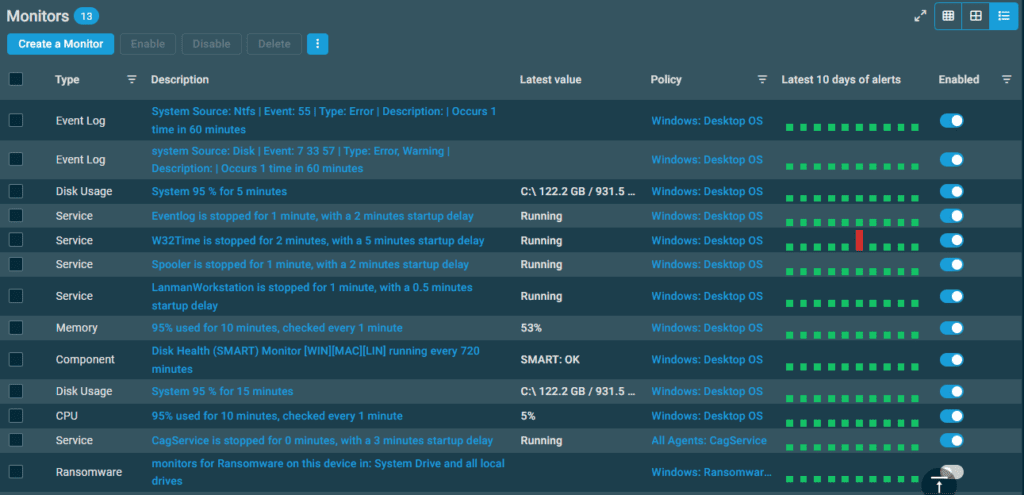You’ll Never Believe How This Simple IT Monitoring Trick Saved a Company Millions!

Introduction:
As an IT consultant, I’ve seen my fair share of technology disasters. From catastrophic data losses to crippling system failures, the consequences of neglecting proper IT maintenance and monitoring can be devastating for any business, big or small.
Let me tell you about one case that still gives me chills whenever I think about it. It involves a small manufacturing firm in the UK that learned the hard way just how crucial proactive IT monitoring is for business continuity.
This company was humming along nicely, churning out high-quality products and riding a wave of steady growth. However, behind the scenes, their IT infrastructure was a ticking time bomb waiting to explode.
Like many small businesses, they had fallen into the trap of thinking, “If it ain’t broke, don’t fix it” when it came to their computer systems. Sure, things were running smoothly on the surface, but without proper monitoring, they were completely oblivious to the early warning signs of an impending disaster.
Little did they know, a perfect storm of hardware failures, software glitches, and good old-fashioned user errors was brewing underneath, threatening to bring their entire operation to a grinding halt. And we’re not just talking about a minor inconvenience here; the potential financial losses they were staring down could have easily run into the millions.
Now, I know what you’re thinking: “Millions? For a small manufacturing company? Surely you’re exaggerating.”
Trust me, I’m not one to exaggerate when it comes to the brutal realities of IT failures. Brace yourself because this cautionary tale is about to take a turn that will have you rethinking your approach to IT monitoring forever.
Company Background:
The company at the heart of this tale was a mid-sized manufacturing outfit based in Manchester. Let’s call them Acme Widgets to protect the not-so-innocent. Despite their generic-sounding name, they were a well-established player in their industry, employing around 75 people and serving a loyal customer base throughout the UK and parts of Europe.
Acme’s bread and butter was churning out specialised machine components and tools for the automotive and aerospace sectors. Quality and precision were essential, meaning their production processes heavily depended on computer-controlled machinery and design software.

In the early days, Acme had the foresight to invest in a reasonably robust IT infrastructure to support its operations. We’re talking servers, workstations, CAD/CAM software licenses—the whole nine yards. However, as the years rolled by and the company expanded, its IT systems slowly but surely fell into a state of neglect.
You know how it goes – when things are ticking along smoothly, adopting that “if it ain’t broke, don’t fix it” mindset is easy. Unfortunately, that’s precisely the trap Acme found themselves in. Their internal IT resources were stretched thin, focused primarily on putting out daily fires rather than proactively maintaining and monitoring their systems.
As an IT consultant who has worked with countless small-to-medium businesses, I can relate to this scenario. Busy owners and managers often prioritise other areas of the business, treating IT as an afterthought until something goes drastically wrong. Little did Acme realise that their lack of IT vigilance was about to come back and bite them where it hurts most—their bottom line.
The IT Disaster Looming:
Picture this: it’s a typical Monday morning at Acme Widgets. Employees are trickling in, firing up their computers, and getting ready to tackle the week’s production targets. But something’s not quite right. The usually peppy CAD software seems to be dragging its feet, taking ages to load projects. Strange error messages are popping up on some workstations, only to disappear before anyone can make sense of them.
The IT manager is scratching his head in the server room, trying to figure out why the network is running slower than Treacle on a cold day. He’s been meaning to investigate these odd quirks for a while now, but there’s always been some other pressing issue to deal with first.
Little does he realise that these seemingly minor hiccups are the precursors of a much larger problem lurking beneath the surface. The company’s central file server, which houses all their critical design files, customer data, and financial records, is quietly grinding its gears, edging closer to a catastrophic daily failure.
You see, the server’s hard drives had been showing signs of wear and tear for months. Intermittent read/write errors and longer-than-usual access times – are all classic symptoms of impending hardware failure. However, without a proper monitoring system in place to detect and alert the IT team to these red flags, they went largely unnoticed.
Now, I know what you’re thinking: “Surely they had backups, right?” Well, yes and no. They did have a rudimentary backup system in place, but it was far from foolproof. The backups were run sporadically, often skipped during busy periods, and rarely tested for integrity. In short, it was a disaster waiting to happen.
If that server were to give up the ghost, taking all that precious data with it, the consequences for Acme would be nothing short of catastrophic. We’re talking about the potential loss of months, if not years, of critical design work, not to mention the financial records needed to keep the business running smoothly.
And let’s not forget the ripple effect such a failure would have on production. Without access to their design files and customer orders, Acme’s entire manufacturing process would halt. Missed deadlines, angry customers, and a tarnished reputation would be just the tip of the iceberg.
The scary part? This nightmare scenario was not a matter of if but when. And time was running out for Acme to take action before it was too late.
The Simple IT Monitoring Trick:
Just as Acme was teetering on the brink of IT catastrophe, a stroke of luck brought them into contact with Cloud 4 Sure. I had been brought in to consult on a separate matter, but it didn’t take long for me to spot the glaring gaps in their IT monitoring and maintenance practices.
After a bit of gentle prodding (and maybe a few well-placed horror stories from my previous consulting gigs), I convinced Acme’s management team to let me implement a simple yet powerful IT monitoring solution.
When most people hear “IT monitoring,” they picture some elaborate, expensive setup with all the bells and whistles. But the truth is, effective monitoring doesn’t have to break the bank or require a degree in rocket science to implement.

The trick that saved Acme’s bacon was a clever little agent we installed on all the servers and workstations. The beauty of this approach was its simplicity and affordability. With just a few hours of setup and configuration, we were able to deploy a robust monitoring system that kept a watchful eye on Acme’s entire IT infrastructure 24/7.
Here’s how it worked: The monitoring software periodically checked the vital signs of all the critical systems and applications, looking for any signs of trouble. If something looked amiss—say, a hard drive showing signs of failure or a network switch experiencing unusual latency—the system immediately fired off an alert to the IT team, complete with all the relevant details they needed to investigate and resolve the issue.
The key to this monitoring trick’s success was its proactive nature. Rather than waiting for something to break and then scrambling to fix it, Acme’s IT team could now stay one step ahead of potential problems, nipping them in the bud before they could escalate into full-blown crises.
But the real magic of this simple monitoring trick was yet to be revealed. Little did Acme know that their newly implemented early warning system was about to prove its worth in ways they could never have imagined.
Averting Catastrophe:
Remember that ticking time bomb of a file server I mentioned earlier? Well, it turns out that our trusty monitoring system had been closely monitoring it from the moment we hit the “go live” button.
A few days after the implementation, the monitoring tool started firing off alerts like there was no tomorrow. The server’s hard drives showed increasingly worrisome signs of degradation, with read/write errors spiking to alarming levels. It was clear that a total failure was imminent, and the potential consequences were devastating.
But here’s where the power of proactive monitoring really shone through. Instead of being caught off guard by a sudden server meltdown, Cloud 4 Sure’s team was able to spring into action with laser-focused precision.

Armed with the detailed information provided by the monitoring system, we quickly diagnosed the severity of the issue and realised that a complete hard drive replacement was the only way to avert disaster. Because we had caught the problem early, we had the luxury of time to plan and execute the fix with minimal disruption to the business.
Picture this: the IT team working tirelessly through the night, carefully migrating critical data to a temporary storage solution while they sourced and installed brand new, high-performance hard drives. It was a high-stakes operation, but one that was only possible because of the monitoring system’s early warning.
In the end, the server was successfully rebuilt and restored to full functionality without so much of a hiccup in Acme’s day-to-day operations. Had the hard drive failure struck without warning, the outcome could have been drastically different.
By catching the issue early, Acme avoided a catastrophic data loss scenario that could have easily put them out of business. Considering the potential costs of lost productivity, missed deadlines, and damaged customer relationships, this simple monitoring trick saved the company millions in the long run.
But the benefits didn’t stop there. The successful avoidance of disaster served as a powerful wake-up call for Acme’s management team, highlighting the critical importance of proactive IT monitoring and maintenance.
The Aftermath and Lessons Learned:
In the weeks and months following their brush with IT disaster, Acme underwent a dramatic shift in its approach to technology management. The close call had served as a stark reminder that neglecting IT best practices was risky and potentially catastrophic for the business.
The management team wasted no time elevating IT to a top strategic priority. They realised that technology was an enabler and a critical driver of their success in an increasingly digital world. With this newfound appreciation, they invested in a comprehensive overhaul of their IT infrastructure, processes, and personnel.
At the heart of this transformation was a renewed commitment to proactive monitoring and maintenance. The simple monitoring trick that had saved them from disaster became the foundation of a much more sophisticated and comprehensive IT management framework.
We expanded their monitoring capabilities to cover every aspect of their technology stack, from servers and networks to applications and endpoints. Robust alerting and escalation procedures were implemented to ensure that no issue, no matter how small, would slip through the cracks.
However, perhaps the most significant change was in the company culture itself. Acme’s leadership clarified that IT was no longer an afterthought but a core part of everyone’s job. Employees were encouraged to report any technology issues or concerns promptly, and regular training sessions were held to promote best practices in data security, system usage, and more.
The results of this cultural shift were nothing short of remarkable. With a proactive, vigilant approach to IT management, Acme was able to catch and resolve potential issues before they could impact the business. System downtime became a rarity, and the company’s productivity and efficiency soared.
But the benefits went far beyond just avoiding disasters. By embracing IT best practices, Acme was able to optimise its technology investments, streamline its processes, and unlock new opportunities for innovation and growth. They even saw significantly reduced IT support costs, as fewer reactive firefighting measures were needed.
Looking back, it’s clear that the simple IT monitoring trick was just the catalyst for a much larger transformation. It showed Acme the immense value of proactive technology management and inspired them to make it a core part of their business strategy.
As an IT consultant who has seen my fair share of technology mishaps, I can’t stress enough how crucial it is for businesses of all sizes to prioritise IT monitoring and maintenance. The cost of neglect is too high in today’s digital landscape.
Call to Action:
If there’s one thing I hope you’ll take away from Acme’s story, it’s that no business, no matter how small or successful, can afford to overlook the importance of proactive IT monitoring and management.
The risks are too great in today’s digital age. Cyber threats, hardware failures, and human errors are not questions of if but when. And when they strike, the consequences can be financially and reputationally devastating.
But the good news is that protecting your business from these risks is entirely within your control. By investing in the right tools, processes, and expertise, you can build a robust, resilient IT infrastructure that safeguards your critical data and systems and enables you to thrive in an increasingly competitive landscape.
So my challenge to you is this: don’t wait for a disaster to strike before taking action. Start prioritising your IT monitoring and maintenance today. Whether implementing a monitoring tool like Nagios, Zabbix or partnering with Cloud 4 Sure to guide your technology strategy, every step you take towards proactive management is a step towards a more secure and successful future for your business.
And remember, you don’t have to go it alone. Cloud 4 Sure are here to help you every step of the way.
So don’t let your business become another cautionary tale. Take control of your IT destiny today, and start reaping the benefits of a proactive, strategic approach to technology management.
Trust me, your future self (and your bottom line) will thank you for it.
As Acme’s story so powerfully illustrates, sometimes all it takes is a simple trick to unlock a world of possibility. So go forth, fellow business leaders, and find your own IT monitoring magic. The future of your company just might depend on it.
